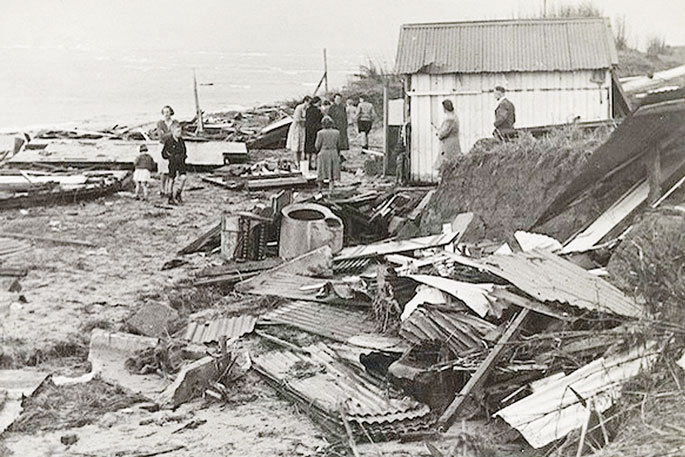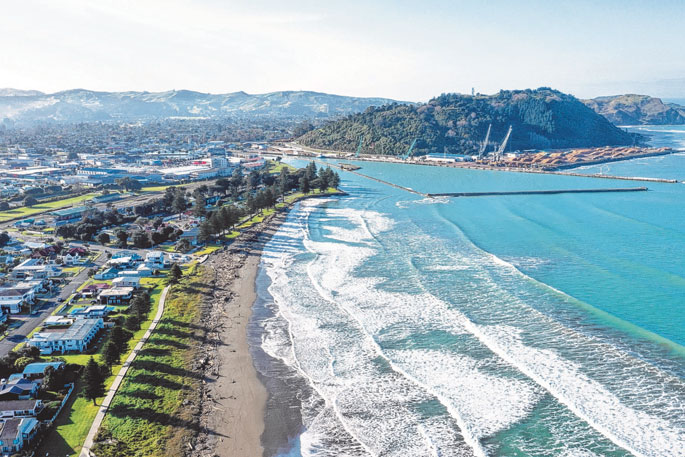Scientists from all around the country descended on Gisborne this week to present on the potential impact of a tsunami in the region.
Tairāwhiti Emergency Management ran a three-day event at Lawson Field Theatre where experts shared their research, joined by National Emergency Management Agency representatives, regional agencies and emergency services.
The region has a significant chance of a major earthquake in the next 50 years because of the Hikurangi subduction zone off the East Coast.
According to Crown research institute GNS Science, the subduction zone is potentially the largest source of earthquake and tsunami hazard in New Zealand.
This weeks' event focused on what would happen during a magnitude 9 earthquake and tsunami.
The first presenter was GNS tsunami team lead David Burbidge, a geophysicist specialising in earthquake and tsunami hazard assessment.
 Two men hold fish stranded by the tsunami that hit the coast north of Gisborne on March 26, 1947. Picture by Harold J Dunstan. Photo: Alexander Turnbull Library/Supplied.
Two men hold fish stranded by the tsunami that hit the coast north of Gisborne on March 26, 1947. Picture by Harold J Dunstan. Photo: Alexander Turnbull Library/Supplied.
Burbidge began by explaining what a subduction zone is — an area where oceanic and continental plates collide.
He gave the example of looking south from Gisborne, where everything on your left would be the Pacific plate, and the rest of the North Island on your right being the Continental plate.
Burbidge has mapped subduction zones all around the world and said in the last 100 years it was these areas that had hosted all of the 8.7 or higher earthquakes.
Often it was the secondary effects of earthquakes, such as tsunami, that created the most issues, he said.
In the case of the third most destructive earthquake on record — the 2004 Indian Ocean event which clocked 9.3 on the Richter scale — 99.5 percent of the 228,100 deaths were the result of the ensuing tsunami.
'That is a really good example where the secondary effects were way more damaging in terms of loss of life,” he said.
 The remains of a house destroyed by a tsunami in the district in 1947. Picture by Harold J Dunstan. Photo: Alexander Turnbull Library/Supplied.
The remains of a house destroyed by a tsunami in the district in 1947. Picture by Harold J Dunstan. Photo: Alexander Turnbull Library/Supplied.
Tairāwhiti hasn't had a major tsunami since 1947 when two earthquakes, measuring 7.0 and 6.9, triggered separate ones in March and May of that year. There was no loss of life.
While it was impossible to predict earthquakes, it was possible to estimate their likelihood over a long period of time.
Whether there could be one 8.7 or higher off the coast of New Zealand depended on if you took an 'optimistic” or 'pessimistic” view, but every subductive zone could produce one of that magnitude given enough time, Burbidge said.
Jose Borrero — from marine consulting organisation eCoast — has studied tsunami since the mid 1990s and compared the landscape of Tairāwhiti to that of Sendai, where the 2011 tsunami had devastating effects.
'This is a low-lying coastal area, very similar I think to the Poverty Bay Flats.”
Borrero presented 'sobering” animations he had created for the district council, which showed the impact a series of waves would have on Poverty Bay, sweeping through the CBD.
'(You could) expect multiple waves and widespread destruction.”
Borrero said debris would also be a problem, with logs being pushed into town, creating a wall of waste propelled by rushing water.
An audience member wondering if a tsunami could reach the hospital was reassured it was not within reach of such an event.
GNS earthquake geologist Kate Clark was the last to present in the morning session, and made the point that the 1947 tsunamis were the result of 'reasonably large” earthquakes that were not strongly felt in the region.
Clark showed archival images, including one from Pouawa where people were caught in a cottage and tossed around 'like being in an agitated washing machine”. Miraculously, they all survived.
'Both of these are what we call tsunami earthquakes. They're a particular category of earthquakes that are really characterised by producing large tsunamis for the relatively moderate size of earthquakes that they are,” she said.
'They're usually only weakly felt, which is really concerning for how people might self-evacuate in response to such an event.”
Despite a bleak outlook for the region should a tsunami hit, a positive message still made it through — although tsunamis couldn't be prevented, people can lessen the human impact by acting fast and moving to higher ground as soon as possible.
The workshop concluded at 1pm Wednesday.
-Local Democracy Reporting is Public Interest Journalism funded through NZ On Air.




1 comment
Chile tsunami
Posted on 23-09-2022 12:13 | By CliftonGuy
One of my concerns would be a strong earthquake off the coast of Chile. Our east coast would be in the direct firing line of a tsunami crossing the Pacific Ocean. It was shown in the Boxing Day event how these can cross great distances and affect places far away.
Leave a Comment
You must be logged in to make a comment.